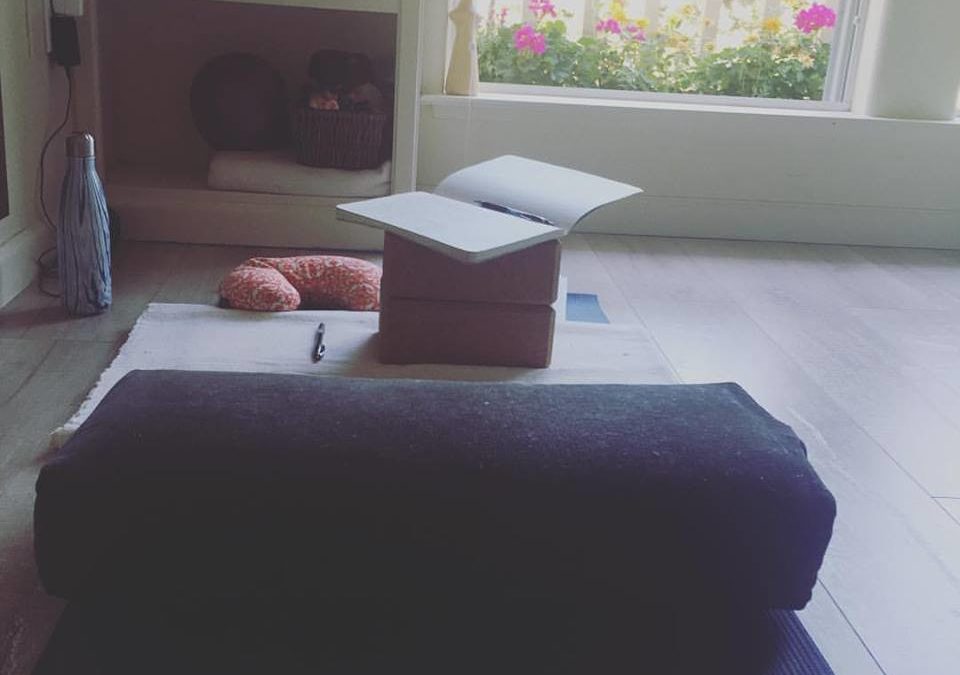20 Minutes a Day Keeps the Chaos Away
But the practice that has stuck with me the longest is the very brief and powerful journaling and meditation practice that we learned in that intensive.
This is a practice that I have taught each morning at the retreats that I co-lead, and I always love sharing it with our participants. I know several of those yogis STILL do this practice 3-4 times a week!
And it’s a practice that I do myself most mornings.
I can’t tell you how much I’ve learned about myself, how it has helped me settle and connect, and how very simple it is. I hope you’ll try it with me.
The practice has 3 parts:
- The Quadrinity Check-in
- Morning Pages
- Pranic Breath Meditation Practice
Quadrinity Check-In Journaling & Meditation Practice
This contemplative practice is a 20-minute guided audio practice. You will need:
- A journal and pen (I love the handmade journals from Galison)
- A comfortable place to sit, either on the floor or meditation cushion, or in a chair
- A place to write (I like to use 2 cork blocks with a bolster across the top if I’m on the floor, but you can also do this at a table/desk)
Settle into your seat, open your journal, and let’s get started! Hit play below.
Quadrinity Check-in
The Quadrinity model is one that Christina Sell and Gioconda Parker used consistently in the Alchemy of Flow and Form 300-hr advanced teacher training. In fact, Christina still teaches this in her new online training program, The Fourfold Path of Practice and Teaching.
The 4 parts of the quadrinity (Physical Body, Intellectual Body, Emotional Body, and Spiritual Body) can be mapped to many other philosophical and yogic models, including:
- The traditional four paths of yoga:
- karma yoga – yoga of action (Physical)
- jnana yoga – yoga of knowledge (Intellect)
- bhakti yoga – yoga of devotion (Emotion), and
- raja yoga – yoga of wisdom and meditation (Spirit)
- The Chakra system:
- Physical relates to the root chakra of basic needs
- Emotion to the heart chakra,
- Intellect to the third-eye chakra, and
- Spirit to the crown chakra
- The Koshas/Sheaths of the subtle body:
- Physical maps to the annamaya kosha, the physical layer of the body, and to the pranamaya kosha, the breath layer
- Intellectual maps to the manomaya kosha, how our brain takes in and processes the information from the senses
- Spiritual maps to the vijnanamaya kosha, the layer of higher knowledge and
- Emotional maps to the anandamaya kosha, the bliss layer of our deepest self
- Christina has also said that these four parts correspond to different students in our yoga classes, and to us as yoga teachers:
- Athletes and Dancers associate with the Physical Body
- Scientists and Engineers associate with the Intellectual Body
- Philosophers and Poets associate with the Emotional Body, and
- Mystics and Monks associate with the Spiritual Body
The cool thing is that ALL of the paths in lead to the same end point: the Spirit.
We all have varying parts of ourselves that are dominate on any given day and in our lives at the current moment, but those of us who are on the path of yoga and self-discovery ALL wind up in the Spiritual body eventually.
The quadrinity check-in has a way of getting us very quickly (in a matter of minutes) from the physical sensations of the body, through the mind, into the heart, and then to the sprit.
Morning Pages
The ritual of Morning Pages was first developed and coined by Julia Cameron in her book, “The Artist’s Way.” In that book, Ms. Cameron recommends writing for 3 pages. I usually write in my own practice for 10 minutes. But in the interest of getting the entire practice into 20 minutes, I condensed the writing to just 5 minutes in this audio. Feel free to hit pause on the recording if you have more to write!! Get it all down and out of your head!
Pranic Breath
Prana means “life force.” When we breathe deeply in and out through the nose using diaphragmatic breathing, we increase our vitality and energy, and we are also tapping into the parasympathetic nervous system, which helps us nourish, heal, and settle. Spending time in meditation, focusing on the movement of the breath, is a very important and beneficial activity. If you’re only practicing the physical postures (yoga asana), you’re only experiencing a small part of the yoga practice.
These 5 minutes will go very quickly, and your mind and body will become more accustomed to sitting this way, focusing on your breath, as you practice regularly. The mind WILL flit around, this is normal. Try to just stick with it and relax.
Hari Om
The chant at the end, Hari Om, is a chant that I have shared on many retreats and in classes occasionally, and again, learned from Christina and Gioconda. Here is a quote from Gioconda:
“Hari means ‘the remover,’ and is referencing a form of Krishna who is the remover of pain and suffering, the mitigator of karma. The mantra Hari Om contains the cosmic vibration that moves us away from suffering and toward that which we desire most.”
This chant has a lyrical quality of being carried away, and you may chant along with me in your practice, or just enjoy listening to the mantra.
You just checked it with the four parts of yourself: Physical, Intellectual, Emotional, and Spiritual (P.I.E.S.), wrote in a free-writing style for 5 minutes, and practiced Pranayama (breathwork) for 5 minutes using the Pranic Breath technique.
How do you feel?
I invite you to try to follow this practice a few times a week (or even every day, if you can) for the next month or so.
For me, one of the things that I find interesting is how some of the things I write stay the same from day to day (can you say, pattern??) and some things shift quite a bit. In my journaling, sometimes I start out venting about a problem I’m having and find that I’ve solved it just through the writing.
And 5 minutes of stillness right AFTER the brain dump feels good to me, since my mind tends to have gotten through some of the junk, and I can just settle.
Did you have a similar or different experience? I’d love to hear about it! Let me know in the comments below!
Where the concept of Morning Pages comes from, and many more little rituals to increase your creativity and discover the artist within you. A great book!
A good, lined journal. You just can’t beat it. I love the gorgeous patterns and size of these handmade journals. So many to choose from.




 Empowering women who are 40+ to install movement habits that are nourishing, strengthening, and approachable for a truly calm and connected life.
Empowering women who are 40+ to install movement habits that are nourishing, strengthening, and approachable for a truly calm and connected life.